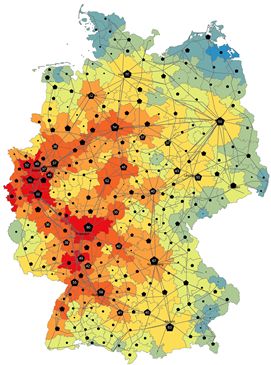Topic: Transportation infrastructure determines accessibility and, thus, the spatially unequally distributed potential for interaction. Accessibility is an important prerequisite for knowledge exchange and production which, against the background of the economy’s transformation into a knowledge economy, has an increasing influence on urban and regional development. Because of the expansion of high-speed rail (HSR) in many countries—including Germany— in recent decades, HSR stations are now among the central access points for national passenger transportation. Through their accessibility effects, they not only influence the probability of interaction between locally-established companies and households, but also have the potential to catalyze locational decisions and thus affect the spatial structure itself in the medium to long term. These catalytic effects make HSR a potential instrument of regional planning and policy. This is of high societal and political relevance, particularly against a backdrop of past and future large public investments into HSR infrastructure.
In scientific terms, the most interesting question is whether medium and long-term effects of HSR stations, which depend on further influencing factors, can be observed. The recent academic discussion on the assessment of these effects is far from unequivocal and emphasizes the need for further research. Moreover, it focuses on the fast-growing transportation systems in China, Spain, and France; these, however, are only to a limited extent comparable with the German system. In addition, most studies consider the effects of accessibility improvement through aggregated inputs and outputs, while lacking spatially differentiated analyses and local drivers as well as qualitative bottom-up methods.
From a spatial perspective, we are interested in discontinuous and contrastive effects produced by HSR. The specific characteristics of HSR mean that, unlike in the case of road infrastructure, positive effects are mainly to be expected on the centrally-located “nodes” of the network. At the same time, HSR may have the potential to alter the spatial distribution of “peripheral” and “central” spaces itself with regard to accessibility. This affects both actual and perceived accessibility because HSR stations can also project an image that affects the use of space.
The aim of this project is to estimate systematically the functional and spatial effects of HSR stations in Germany at scale levels relevant for decision-making. A particular emphasis is placed on the connection between increased accessibility in the local and regional environment of HSR stations and the location decisions of knowledge economy firms. Our approach is based on a contrasting comparison of case studies and the principle of methodical triangulation : Quantitative and qualitative approaches complement each other both in terms of the fine-grained nature of the data used and the combination of scientific spatial analysis methods. In this way, we contribute to understanding the mutually reinforcing, catalytic effects of HSR infrastructure in Germany.
The project draws on longstanding research expertise on the knowledge economy and transportation networks at the Chair of Urban Development, as well as on the doctoral thesis of a team member, which can now be continued thanks to a 2.5-year research grant by the Deutsche Forschungsgemeinschaft (DFG).
Researchers: Fabian Wenner, Johannes Moser, Alain Thierstein; research group "Land Use, Infrastructure, Spatial Transformation"
Principal: Deutsche Forschungsgemeinschaft (DFG)
Cooperation partner: ILS–Institut für Landes- und Stadtentwicklungsforschung
